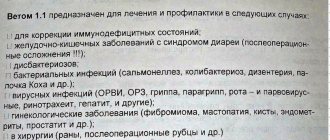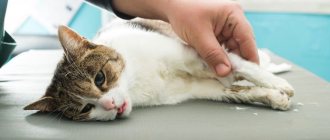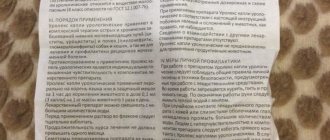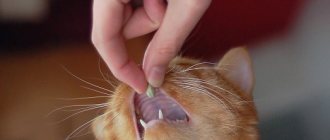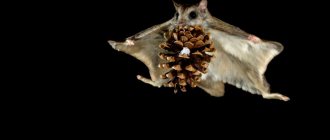Home » Treatment of cats » Canephron for cats
Canephron for cats is a herbal medicine used to treat diseases of the genitourinary system in these beautiful animals. The main feature of this medicine is its composition: medicinal raw materials of exclusively plant origin help not to overload the body with synthetic drugs. At the same time, Canephron not only alleviates the condition of the animal during the acute period of the disease, but also promotes accelerated recovery. And in case of chronic urolithiasis, it reduces the likelihood of relapses.
Compound
Canephron contains:
- centaury grass (Centaurium)
- rosemary leaves (Rosmarinus)
- roots of lovage (Levisticum officinale)
Centaury
Biennial, less often annual, plant of the gentian family. Representatives of this family contain bitterness, glycosides (eritaurine, erythrocentaurine), flavonoids, oleanolic acids, gentianine alkaloid, chromium salts.
Centaury grass is credited with many beneficial properties. In the register of medicines of the Russian Federation, centaury herb is listed in the group of appetite stimulants of plant origin (bitterness), has a stimulating effect on intestinal motility and the secretion of glands of the gastrointestinal tract (GIT).
Rosemary officinalis
Evergreen shrub of the Lamiaceae family. The leaves of the plant contain alkaloids, ursolic and rosmarinic acids, and essential oil. Rosemary essential oil contains: pinene, camphene, cineole, borneol, L-camphor, sesquiterpene hydrocarbon caryophyllene, bornyl acetate, limonene, resins and bitterness.
It has the following medicinal properties: tonic, bactericidal, balsamic, antiseptic, diaphoretic, antirheumatic, hypotensive, analgesic, choleretic, antispasmodic, diuretic.
Lovage officinalis
Perennial herbaceous plant, fam. umbrella All parts of the plant contain essential oil, which contains: D-terpineol cineoacetic, isovaleric, benzoic acids. The following were found in lovage roots: resins, organic acids (angelic, malic), starch, sugars, carvacrol, sesquiterpenes, furocoumarins (psoralen and bergapten), tannins and minerals.
Lovage is not used in scientific medicine, and just like rosemary leaves, it is not included in the Register of Medicines of the Russian Federation. But it is registered in some foreign pharmacopoeias. It is believed to have a diuretic, expectorant, tonic, analgesic, sedative effect, relieve spasms, and promote the removal of stones and sand from the bladder and kidneys.
Release form and composition
The drug, produced in liquid form, contains the following herbs:
- lovage root;
- rosemary leaves;
- centaury grass.
The medication is a diuretic of plant origin.
Canephron is prescribed to cats for oral administration in the form of a solution weighing 100 g. The drug in liquid form has a yellow-brown color and has a distinct, specific odor. As a result of long-term storage, a small sediment appears.
Centaury herb has the following effects:
- antispasmodic;
- anti-inflammatory;
- prevents capillary permeability;
- affects intestinal motility;
- improves blood formula.
The plant contains bitter glycosides, essential oils, nicotinic acid, vitamin C, and trace elements.
Lovage root contains the following substances:
- terpineol;
- acetic acid;
- sesquiterpene;
- corvaclol;
- sugar;
- starch;
- furocoumarins;
- mineral.
The plant has the following effects:
- decongestant;
- increases hemoglobin;
- anthelmintic;
- eliminates the symptoms of pyelonephritis;
- improves digestion;
- diuretic.
Release form
The drug is produced in 2 forms: pills and drops. Both are used for cats, each has its pros and cons.
The pills contain more excipients, which increases the likelihood of allergies or adverse reactions. The tablets are covered with a protective coating, which, if violated, reduces the effectiveness of the drug.
The drops contain ethyl alcohol, which has a negative effect on the pancreas and liver of cats. But it’s easier to give and dose drops.
pharmachologic effect
Diuretic (diuretic) product of plant origin. Used for the treatment and prevention of diseases of the excretory system in cats: nephritis, urolithiasis, uremic syndrome, cystitis - as part of complex treatment. The use of Canephron for chronic renal failure (CRF) is controversial.
The essential oils and flavonoids that make up Canephron dilate the blood vessels of the kidneys, thereby improving the nutrition of the renal epithelium, increase diuresis, but do not increase the excretion of potassium from the body (potassium ions are important for the normal functioning of organs, primarily the heart).
Rosmarinic acid has an anti-inflammatory effect. Flavonoids and rosemary oil relieve spasms, reducing pain in the cat.
The drug reduces the amount of protein excreted through the kidneys, which helps maintain normal blood composition in a sick animal, prevents the formation of uroliths (stones) in the kidneys and bladder, by restoring normal urine pH. Normally, cat urine does not contain protein, but during inflammatory processes, the normal process of blood filtration and urine formation is disrupted. Blood protein leaks through the kidneys, damaging their epithelium and acidifying the urine.
Canephron has a bacteriostatic effect - it interferes with the normal functioning of bacteria that cause the disease, including those that are insensitive to antibiotics. The drug combines well with antimicrobial drugs, enhancing their therapeutic effect and reducing side effects due to its diuretic effect.
Instructions for use
Canephron N – solution
Trade name of the drug
Canephron N
Dosage form: oral solution
Compound:
100 g of solution contains
Active Ingredients:
- 29 g of hydroalcoholic extract from medicinal plant materials:
- Centaury grass – 0.6 g
- Lovage medicinal roots – 0.6 g
- Rosemary leaves – 0.6 g
- Excipients:
- Purified water – 71.0 g
Description
A clear or slightly cloudy liquid, yellowish-brown in color, with an aromatic odor. A slight sediment may form during storage.
Pharmacotherapeutic group
Diuretic of plant origin.
Indications for use
The drug is used in complex therapy in the treatment of chronic infections of the bladder (cystitis) and kidneys (pyelonephritis), for non-infectious chronic inflammation of the kidneys (glomerulonephritis, interstitial nephritis), as a means of preventing the formation of urinary stones (also after removal of urinary stones).
Contraindications
Hypersensitivity to the components of the drug, children (up to 1 year). Peptic ulcer of the stomach and duodenum in the acute stage. Alcoholism (including after anti-alcohol treatment).
With caution: liver disease, traumatic brain injury, brain disease, children (over 1 year) (use only after consultation with a doctor) - due to the ethanol content. Use during pregnancy and breastfeeding
Use during pregnancy and breastfeeding
The use of the drug during pregnancy and breastfeeding is possible only as prescribed by a doctor, if the expected benefit to the mother outweighs the potential risk to the fetus and child.
Directions for use and doses
After the severity of the disease has subsided, treatment with the drug should be continued for 2 to 4 weeks.
If necessary, for example, to soften the bitter taste for children, the drug can be taken with other liquids.
During treatment with the drug, it is recommended to consume plenty of fluids.
Shake before use!
Side effect
Allergic reactions are possible. Dyspeptic disorders (nausea, vomiting, diarrhea) are possible.
At the first sign of an allergic reaction, you should stop taking the drug.
Overdose
At the moment, there is no data on overdose and intoxication.
In case of drug overdose, symptomatic treatment is prescribed.
Interaction with other drugs
Combination with antibacterial agents is possible and advisable. Interactions with other drugs are currently unknown.
special instructions
For edema caused by cardiac or renal dysfunction, consuming large amounts of fluid is contraindicated.
In case of impaired renal function, the drug should not be prescribed as monotherapy. In case of inflammatory kidney disease, you should consult a doctor for advice.
If there is blood in the urine, pain when urinating, or acute urinary retention, you should immediately consult a doctor.
During storage, slight turbidity or slight precipitation may occur, which does not affect the effectiveness of the drug.
Impact on the ability to drive vehicles and machinery
The content of ethyl alcohol in the preparation ranges from 16.0 to 19.5% (volume)
During treatment with the drug, caution should be exercised when driving vehicles and engaging in other potentially hazardous activities that require increased concentration and speed of psychomotor reactions.
Release form
Oral solution. In a dark glass bottle of 50 or 100 ml with a dispensing drip device on top, with a screw cap and a safety ring, along with instructions placed in a folding cardboard box.
Store in a dry place, protected from light, at a temperature not exceeding 25 °C.
Keep out of the reach of children.
Best before date
3 years.
Do not use after the expiration date stated on the packaging.
Opened bottles can be used for 6 months.
Instructions for use and dosage
Before use, consultation with a veterinarian is required. Canephron is a medicine tested and used in humanitarian medicine; the instructions for use do not contain a dosage for a cat. It has been used recently in veterinary medicine, so there are no standard prescriptions for cats; the amount of the drug depends not only on the weight of the animal, but also on its physiological characteristics and severity and condition. Prescribe 5-10 drops per adult cat 1-2 times a day. It can be given either by mixing with water or adding to food. If tablets are prescribed: 1/2 - 1/4 tablets 2 times a day. But when dividing the tablet into parts, the shell is broken, which significantly reduces the effectiveness of the drug. The duration of the course is from several days to 1 month.
Canephron N (drops) contains alcohol. The strong smell repels cats. When mixing with water, you can wait a little (10-30 minutes) for the smell to weaken or disappear.
Dosage
The dosage of the drug is determined by the veterinarian. Different dosage forms of Canephron have different dosages.
It is more convenient to give the drug in liquid form to cats. The dose is calculated based on the pet’s weight - 1-2 drops per 1 kg of body weight. The course of treatment is 30 days, dosage is 2 times a day. The drug must be diluted with a small amount of water and forcefully poured into the cat’s mouth.
The dose of Canephron in tablet form is calculated as follows:
- ½ tablet for an adult cat per appointment;
- ¼ tablets for kittens and animals under 3 years old.
Course intake - twice a day for a month. If necessary, the veterinarian can prescribe a second course in 2-3 weeks.
Use of Canephron in cats: controversial issues
At the moment, there are no scientific studies, confirmed data on testing Canephron and verifying its effectiveness for cats. Reviews about the drug on the Internet from animal owners and veterinarians do not lead to a consensus. Phenolcabolic acids, which are part of Canephron, can have a toxic effect on the liver of cats, like other phenol derivatives. The harm/benefit ratio for cats when using alcohol and terpene compounds in the medicine is unclear.
How to use Canephron for cats
Our pets will not willingly use this herbal medicine themselves. Having bought the drug at the pharmacy, you will not find in the instructions for use how it can be used for a cat. The dosage depends on the form of release and the weight of the animal.
In tablets
Cats are given Canephron in tablet form to take 2 times a day based on the following proportion: 1/4–1/2 of the whole tablet.
A quarter of the dragee is given to young cats, and a half to well-fed heavy animals. The medicine should be taken with plenty of water. Duration of admission - from 28 to 35 days.
It is recommended to give medicine to your pet in the following order:
- Measure out the required amount of medication.
- Place the cat so that it is convenient to open its mouth, and it does not resist, trying to scratch.
- Place part of the tablet on the root of the tongue and close the animal's mouth, waiting for swallowing.
- Give the cat water and try to calm your pet.
Did you know? A cat's sense of smell is 14 times stronger than a human's, but inferior to a dog's sense of smell. Their taste is also developed - cats distinguish between bitter, salty and sour foods.
To prevent the animal from scratching, you can wrap it in a towel. It is also worth trying to give the medicine with food, but the cat may refuse food with a herbal scent.
In solution
Due to the ethyl alcohol content, hydroalcoholic extract is not the best drink for a cat. Therefore, the recommended number of drops must first be mixed in a small volume of water (2 ml) and allowed to stand so that the alcohol evaporates.
The recommended dosage (it is the same as in drops) can be drawn into a syringe for easier administration. The syringe should be placed in the corner of the mouth, behind the fang, then slowly squeeze the liquid from the syringe into the oral cavity at the rate of 1 ml at a time, so that the pet has time to take a sip and does not choke.
After introducing the entire norm, the animal’s mouth should be closed to completely swallow the liquid. Then the cat should be given plenty of clean water at room temperature.
Also find out why cats have a wet nose and what a dry nose means.
In drops
In liquid form, the drug is prescribed at the rate of 1–2 drops per 1 kg of cat weight. Usually this is 3-10 drops. As the exacerbation of the disease subsides, the dosage rate is reduced.
The duration of treatment is 30 days. After 14–21 days, the medication can be taken again, depending on the condition of the animal.
Analogs
Drugs similar to Canephron in composition and action:
- Cyston (a drug of plant origin. Available only in tablets. It contains more different herbs, but because of this, the risk of allergies is greater);
- Phytolysin (paste based on essential oils and medicinal raw materials of plant origin. Effective for urolithiasis, but has a very strong odor);
- Phytoelite healthy kidneys for cats (tablets based on extracts, decoctions and infusions of medicinal plant materials)
- Kotervin (water infusion of medicinal herbs for cats, has a diuretic, salt-removing and anti-inflammatory effect)
- Stop-cystitis (suspension containing both extracts from medicinal plants and synthetic drugs with antispasmodic and antibacterial effects)
- Nephroprotector Divopride (tablets based on bearberry and Pol-Pala extracts for the treatment of diseases of the urinary system with mild edematous syndrome, diuretic).
The possibility of replacing the drug with an analogue is determined by the veterinarian.


